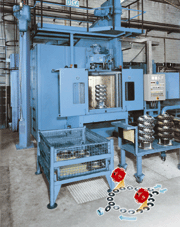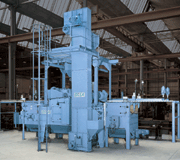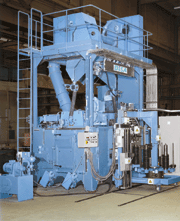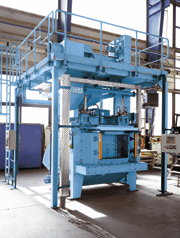E-Archive
Cover Page
in Vol. 4 - September Issue - Year 2003
Shot Peening Systems to Customer Requirement

Satellite-type shot peening machine for circular parts

The RD family includes shot and stress peening machines

DR-2 Shot Blast Machine with automatic loading system for clutch springs

DR-2 Shot Blast Machine
Founded in 1900, DISA is the world‘s leading supplier of foundry equipment, metal surface finishing systems, and air pollution control solutions. DISA is constantly setting new standards in the industry through an outstanding commitment to research and development. With 2500 employees, DISA is represented world-wide with production facilities and sales and service subsidiaries on three continents, and an extensive agent network. DISA is part of the A. P. MOLLER-MAERSK GROUP
This presentation describes some of the shot peening systems offered by DISA and shows how one of the main German players in automotive and motor bike production are employing three such machines in the peening of gear parts and other components.
DISA is a leading international manufacturer of shot blast and shot-peening systems. The organisation, has competence centres and production facilities for shot blast systems in Schaffhausen, Switzerland; Hagen, Germany; Pribram, Czech Republic; Seminole, USA; Bangalore, India; and Changzhou, People’s Republic of China. The product portfolio for shot blast application is impressive, covering almost every requirement of manufacturing industry. The designs bring together the accumulated experience of four famous names in the production of shot blasting equipment – Georg Fischer, BMD, Vogel & Schemmann and Goff.
The organisation has many years experience in the design and manufacture of specialised shot-and stress-peening equipment. Typical applications include the processing of a wide variety of gear components; coil, leaf and clutch springs and many other components, which are subject to high alternating stress.
The range of machines covers both batch and continuous throughput models including a newly developed – so called JIG-Type machine which will be presented at a later time. Whereas batch machines are mainly used for small parts and low to moderate process requirements, machines of the throughput-design ensure overall process reliability (defined coverage and Almen values) for all parts shot peened. These machines can be either manually or robotically loaded and unloaded. Although the units are of standard design, individual models are frequently adapted to meet a client’s specific requirements.
For circular or cylindrical workpieces, such as gears, pinions and clutch springs, the DR-design includes two machine-types with 2 or 4 blast wheels and with rotating tables incorporating individual satellite turntables. Each turntable bears a fixture, which can accommodate one or several vertically-stacked workpieces.
A typical satellite machine, the DR-2/0301-100, with up to 17 turntables, can process up to 1000 parts per hour, using two blast wheels. The unit can accommodate workpieces between 150 and 330mm in diameter. The worktables, rotated in the shot zone, are driven by a frequency-controlled geared motor so that rotation speed can always be adapted to the relevant parts being shot peened, turning at approximately 50 rpm. The blast wheels are each mounted on a moveable carriage, the position of which is adjusted to suit a specific clutch spring diameter. The effective shot-peening time, shot throughput and blast intensity for a particular workpiece can be varied continuously in accordance with the desired Almen value and coverage via electric controls. The shot blast machine can be fitted with a fully automatic loading and unloading device. The incorporation of a further “robot” in the system enables the components to be turned over automatically halfway through the cycle and different blasting programmes can be applied for the different blast wheels.
The RD family which includes shot and stress-peening units for processing suspension springs, leaf springs and valve springs utilises horizontal transport carrier rollers to set work-pieces in rotation and a chain with grippers to progress the workpieces past the blast wheels.
DISA also offer more conventional batch-type reverse belt units and overhead monorail-type units for shot peening a variety of components.
BMW purchase three DISA Machines
BMW is among a number of automobile manufacturers who have specified DISA shot-peening systems in the recent past. Two years ago, the company expanded its heat-treatment facilities to meet the increased requirements for a range of automobile components, such as gear wheels and bevel drive-pinions. In turn, this meant that there was a requirement to increase the capacity of the shot-peening department. The specification for the new shot-peening plant included the following requirements:
a) An increase in the endurance life of the components as a result of shot-peening and the simultaneous de-scaling of the parts (gear wheels and bevel drive-pinions) processed singly or in pairs.
b) The tolerance range of the Almen values (lower and upper value) was required to be within the close range of 0,004mm at an optimum overlap between the gear teeth. Failure to keep within these values was likely to result, after the lapping operations, in noise emission from the gearbox.
c) The threads and keyways have to be de-scaled without any consequential hardening effect. In order to ensure this, the sense of rotation of the blast wheels is changed which results in a more flat shot- throwing angle.
To meet these requirements, shot-peening trials were carried out on BMW’s components within DISA’s test centre at Schaffhausen. As a result, DISA suggested that the customer should consider ordering a satellite-type machine embodying a well-proven blast-wheel system, in conjunction with spherical steel shot. The unit was to be specially adapted to BMW’s requirements.
The machine was to be equipped with a turntable incorporating 15 rotation-controlled satellite tables. The two DISA blast wheels, each providing an output of 22kW, were also to be frequency controlled, so that the blast intensity, direction of wheel rotation, and hence the exact blast position, could be adjusted to suit the different gear components. The quantity of shot discharged would be controlled according to the dictates of the pre-selected shot-peening programme, using remote-controlled blast-media metering devices.
The shot-peening programmes were to be tailored to the specific production processes required by the client, and the process reliability was to be guaranteed. Depending on the application, i.e. on the shot-peening time, the minimum cycle time was to be 12 sec.
In the event, BMW purchased its first DISA shot-peening machine in February 2001. The results, having fulfilled all expectations, were such that the company ordered a second machine. This was subsequently installed in September 2001. The units proved easy to operate and they have distinguished themselves in terms of high availability and economic efficiency.
The excellent performance of the two machines led BMW to investigate the possibility of using such a system to de-scale motorcycle gear components. However, it was necessary to avoid work hardening the surface of the teeth and the ball bearing seat during the de-scaling operation. Again, the satisfactory results led to the placing of an order for a third machine. The unit recently commenced production.
Automatic Handling
One of the advantages of the BMW machines is their ability to be loaded manually or automatically. In the case of bevel drive-pinions, the loading and unloading sequences are carried out robotically.
The loading procedure is planned as follows:
The robot gripper retrieves the workpiece from a pallet, grasping the bevel drive-pinion by its shaft, and then swivels to place the component into a central position above the fixture on the satellite table. A further gripper device, activated by a pneumatic cylinder, descends vertically to secure the pinion by its toothed head. The robot then releases the part and retracts. The gripper subsequently lowers the workpiece into the fixture and then moves upwards, back to its original position.
Unloading then takes place as follows:
After the machine table has indexed one position, bringing a processed component into view, the gripper device moves downwards. It grasps the gear drive-pinion and raises it sufficiently for the retrieval robot to move in and secure the component.
At this point, the gripper released its grasp, allowing the robot to withdraw the part from the table and place it in a further pallet.
In modern surface treatment technology, shot peening with blast wheels has been widely accepted as an economical process, which provides the necessary, high process reliability.
For Information:
DISA Industrie AG
P.O. Box, 8207 Schaffhausen, Switzerland
Tel. +41.52.631 1717, Fax 631 4888
E-mail: info.sh@disagroup.ch
www.disagroup.com



























